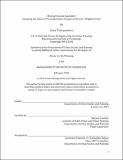| dc.contributor.advisor | Karilyn Crockett. | en_US |
| dc.contributor.author | Techagumthorn, Yanisa. | en_US |
| dc.contributor.other | Massachusetts Institute of Technology. Department of Urban Studies and Planning. | en_US |
| dc.coverage.spatial | n-us-ma | en_US |
| dc.date.accessioned | 2019-07-17T21:00:51Z | |
| dc.date.available | 2019-07-17T21:00:51Z | |
| dc.date.copyright | 2019 | en_US |
| dc.date.issued | 2019 | en_US |
| dc.identifier.uri | https://dspace.mit.edu/handle/1721.1/121751 | en_US |
| dc.description | This electronic version was submitted by the student author. The certified thesis is available in the Institute Archives and Special Collections. | en_US |
| dc.description | Thesis: M.C.P., Massachusetts Institute of Technology, Department of Urban Studies and Planning, 2019 | en_US |
| dc.description | Cataloged from PDF version of thesis. | en_US |
| dc.description | Includes bibliographical references (pages 88-90). | en_US |
| dc.description.abstract | The Federal Aid Highway Act of 1956 provided the funds for Massachusetts to build a system of highways that threatened to cut through various neighborhoods in the greater Boston area. A broad coalition of people put a stop to these plans in 1972, and advocacy at the federal level allowed for highway funds to be shifted to public transportation projects. Many organizations within this coalition had broader goals of improving the livelihoods of their communities beyond just shutting down highways. Since equitable public transportation can play a key role in improving economic mobility, this thesis explores how changes in public transit stemming from the Boston anti-highway movement impacted nearby neighborhoods and assesses the areas that may still be lacking in access to adequate transit today. | en_US |
| dc.description.abstract | In 1987, the Massachusetts Bay Transportation Authority (MBTA) used the funds, which were previously allocated for highways, to close down the old Elevated Orange Line on Washington Street and to build a new Orange Line along the Southwest Corridor nearby. As the replacement for the Washington Street Elevated, the Silver Line opened fifteen years later in the form of a bus route with aspects of bus rapid transit. For this thesis, I conducted a demographic analysis of the census tracts surrounding these two corridors and found that the Orange Line moved from an area with relatively lower incomes, lower education levels, and higher African-American population to an area with relatively higher incomes, higher education levels, and higher non-Hispanic White population. The Silver Line, a bus service inferior to the Orange Line trains, was put into the comparatively disadvantaged corridor. | en_US |
| dc.description.abstract | Zooming out to the rest of Boston, I conducted a geospatial analysis comparing the supply of transit, with respect to job access, to the demand, measured through a series of demographic indicators, and found the areas where the MBTA does not provide equitable service, especially for transit-dependent populations. Dorchester, in particular, stands out as a neighborhood with a high density of low-income, less-educated, minority populations without adequate public transit to get to economic opportunities. | en_US |
| dc.description.statementofresponsibility | by Yanisa Techagumthorn. | en_US |
| dc.format.extent | 90 pages | en_US |
| dc.language.iso | eng | en_US |
| dc.publisher | Massachusetts Institute of Technology | en_US |
| dc.rights | MIT theses are protected by copyright. They may be viewed, downloaded, or printed from this source but further reproduction or distribution in any format is prohibited without written permission. | en_US |
| dc.rights.uri | http://dspace.mit.edu/handle/1721.1/7582 | en_US |
| dc.subject | Urban Studies and Planning. | en_US |
| dc.title | Moving forward equitably? : analyzing the impact of transportation changes on Boston's neighborhoods | en_US |
| dc.title.alternative | Analyzing the impact of transportation changes on Boston's neighborhoods | en_US |
| dc.type | Thesis | en_US |
| dc.description.degree | M.C.P. | en_US |
| dc.contributor.department | Massachusetts Institute of Technology. Department of Urban Studies and Planning | en_US |
| dc.identifier.oclc | 1102053275 | en_US |
| dc.description.collection | M.C.P. Massachusetts Institute of Technology, Department of Urban Studies and Planning | en_US |
| dspace.imported | 2020-03-09T19:57:47Z | en_US |
